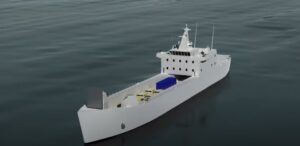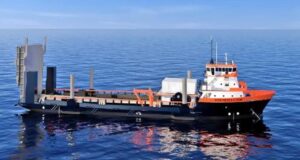The Navy is seeking industrial information from potential medium landing ship (LSM) producers on their ability to build the new ships, with a special interest of building up to four annually, in a recent request for information (RFI).
According to the May 17 RFI, the Naval Sea Systems Command (NAVSEA) is “seeking to understand industrial sources interested in the Detail Design and Construction (DD&C) of the Medium Landing Ship (LSM).”

The RFI is seeking information on several questions with implications for future production including how long is the potential offeror’s detail design phase, its experience designing beaching vessels, the maximum number of vessels it can have in production at the same time, and the optimal number of ships awarded annually to enable maximum learning curve and optimal use of resources.
Notably, the RFI implies the Navy is hoping to be able to procure upwards of four LSMs annually. One question asks interested contractors how many ships can they build at the same time and if they have the resources and production capacity to work on up to four ships per year. If a contractor says it can build four per year, NAVSEA wants them to explain how they can support that number.
If a respondent cannot build up to four ships per year, the RFI asked what is the maximum number it can begin production on annually and if there are any investments or improvements that would allow it to increase production capacity to four hulls per year.
The Navy noted that regardless of reaching four ships built per year, it wants to know what is the optimal number of ships awarded annually for the shipyard to have a maximum learning curve and optimal use of its resources and facilities.
The Navy’s fiscal year 2024 budget request said over the next five years the Navy plans to buy up to six new LSMs, formerly called the Light Amphibious Warship (Defense Daily, March 13).
The RFI also sought the estimated duration from start of construction to delivery for any given LSM design, if that timeline decreases with experience and, if so, what is the shortest duration for construction and by what ship number would that be reached.
Other questions focused on LSM design maturity. The RFI asked if potential offerors had a design that can be further matured in the detail design process, what the level of maturity of the initial design is. If an LSM design is derived from a parent design, the Navy wants to know what level of maturity did it originally have.

If an LSM offering has no parent design, the Navy asked the offerors if there is a parent design they can leverage as a starting point for the detail design and to explain their ability to begin a design at the detail design phase.
The Navy also asked how long the offerors expect their detail design phases will be. If any contractor plans to request a production readiness review (PRR) before the detail design is 100 percent finished, NAVSEA wants to know at what percent finished will they request the PRR.
In March, the Marine Corps Warfighting Lab said it was planning to start four stages of experimentation with prototyping LSM-type vessels this year (Defense Daily, March 6).
The service has contracted with Hornbeck Offshore Services [HOS] to work with a Offshore Support Vessel modified into a Stern Landing Vessel (SLV) to test LSM concepts.
The SLVs will be leased for several years each. The Marine Corps contracts include options for the government to ultimately purchase them.
The first SLV will feature a 12-foot draft, 6,000 square feet of cargo space, the ability to hold 38 Marines and 12-15 commercial mariners, a large ramp, landing skegs, landing legs, and material to protect the rear rudder and prop area.
The final LSM is planned to hold 75 Marines each with their equipment. Nine LSMs are needed to field ech of the three planned Marine Littoral Regiments. Marine Corps officials said they see the need for 35 LSM-type ships, with 27 to move the three MLRs and and eight more vessels to account for maintenance schedules.
In January, Marine Brig. Gen. Marcus Annibale, director of expeditionary warfare (OPNAV N95), said the Navy and Marine Corps agree on an initial capacity of 18 LSMs, while the 19th through 35th vessels could include a mix of other craft like the SLVs or Spearhead-class Expeditionary Fast Transport ships (Defense Daily, Jan. 17).